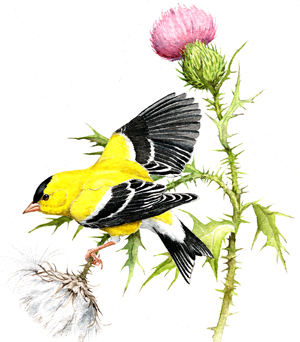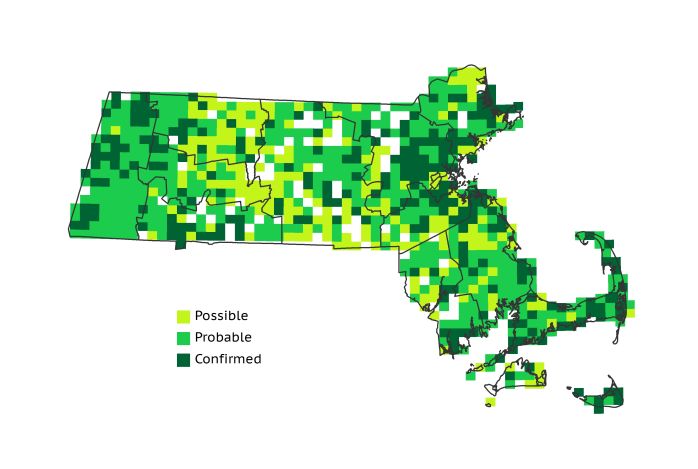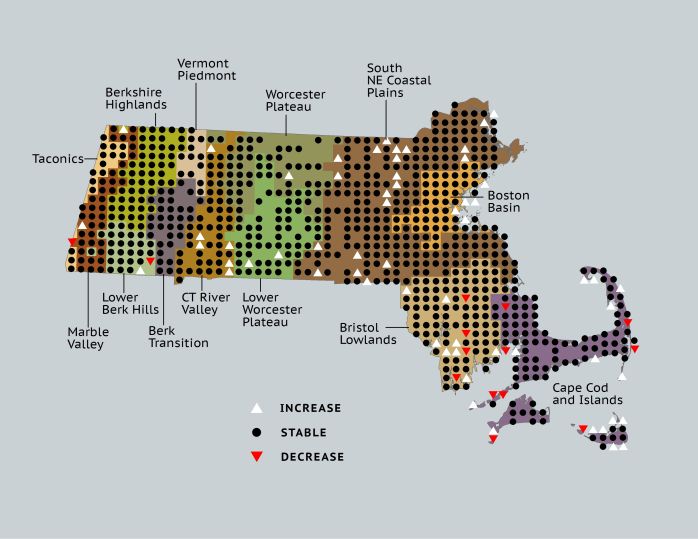Find a Bird
American Goldfinch
Spinus tristis

Nearly ubiquitous and stable
“We saw by the flitting clouds, by the first russet tinge on the hills, by the rushing river, the cottages on shore, and the shore... itself, so coolly fresh and shining with dew, and later in the day, by the hue of the grape-vine, the goldfinch on the willow, the flickers flying in flocks, and when we passed near enough to the shore, as we fancied, by the faces of men, that the fall had commenced.” —Henry David Thoreau, A Week On the Concord and Merrimack Rivers
The American Goldfinch, the so-called “Wild Canary” of the Americas, has long been admired for its sweet song. The bright yellow breeding plumage of the male only enhances the bird’s appeal, making it a favorite visitor of backyard feeders and birdbaths. From the shores of Nantucket to the high hills of the Berkshires, the American Goldfinch can be found breeding just about everywhere in Massachusetts. Despite its delicate appearance, the humble goldfinch is a tenacious survivor.
Historic Status
Relatively little can be added to what is known about the American Goldfinch other than the fact that most historical ornithological publications in Massachusetts, whether local or statewide in their scope, listed the species as a permanent, abundant resident at all times (Peabody 1839, Howe & Allen 1901). The only possible change in its population status may have come in the late 1800s when bird feeding became increasingly popular. A proliferation of bird feeders across the state may have caused more American Goldfinches than usual to remain in Massachusetts through the winter months, though the species reportedly always did so to some degree.
Atlas 1 Distribution
All an American Goldfinch needs to make a living is a bit of edge habitat or second-growth forest, so the Bay State was a perfect haven for goldfinches during Atlas 1, and they were found in 88% of the blocks statewide. Goldfinches made their presence known in every ecoregion west of the Connecticut River Valley; in fact, they were always found in at least 95% of the blocks in any of these regions. They were slightly less commonly encountered in the Connecticut River Valley, especially in the south, but were still widespread. Block occupancy levels hovered around 85% throughout the Worcester and Lower Worcester Plateau regions, as well as throughout the Coastal Plains and the Boston Basin. Numbers were somewhat higher in the Bristol/Narragansett Lowlands and a little lower in the Cape and Islands.
Atlas 2 Distribution and Change
To the delight of backyard birdwatchers across the Commonwealth, goldfinches are thriving in Massachusetts. In Atlas 2 overall they nested in 96% of the state surveyed, and they occupied at least 88% of each ecoregion across the state, and even showed modest gains in most regions. Since the first Atlas this species managed to spread into blocks where it was previously unrecorded and persisted in all but 14 blocks where it was recorded during Atlas 1. Regional gains tend to have less meaning in areas where a species is near saturation as well as in regions where it could eke out few more blocks than it already has.
Atlas 1 Map

Atlas 2 Map

Atlas Change Map

Ecoregion Data
Atlas 1 | Atlas 2 | Change | ||||||
Ecoregion | # Blocks | % Blocks | % of Range | # Blocks | % Blocks | % of Range | Change in # Blocks | Change in % Blocks |
Taconic Mountains | 16 | 100.0 | 1.9 | 22 | 88.0 | 2.2 | 0 | 0.0 |
Marble Valleys/Housatonic Valley | 38 | 97.4 | 4.5 | 38 | 97.4 | 3.8 | 0 | 0.0 |
Berkshire Highlands | 53 | 96.4 | 6.2 | 55 | 100.0 | 5.6 | 1 | 1.9 |
Lower Berkshire Hills | 27 | 96.4 | 3.2 | 29 | 93.5 | 2.9 | 0 | 0.0 |
Vermont Piedmont | 17 | 100.0 | 2.0 | 17 | 100.0 | 1.7 | 0 | 0.0 |
Berkshire Transition | 36 | 94.7 | 4.2 | 39 | 97.5 | 3.9 | 0 | 0.0 |
Connecticut River Valley | 48 | 85.7 | 5.6 | 64 | 98.5 | 6.5 | 6 | 12.5 |
Worcester Plateau | 66 | 84.6 | 7.7 | 87 | 98.9 | 8.8 | 1 | 2.1 |
Lower Worcester Plateau | 63 | 85.1 | 7.4 | 79 | 98.8 | 8.0 | 2 | 3.7 |
S. New England Coastal Plains and Hills | 237 | 87.8 | 27.8 | 278 | 98.2 | 28.1 | 21 | 9.3 |
Boston Basin | 48 | 85.7 | 5.6 | 54 | 96.4 | 5.5 | 5 | 9.1 |
Bristol and Narragansett Lowlands | 94 | 88.7 | 11.0 | 101 | 88.6 | 10.2 | 3 | 3.0 |
Cape Cod and Islands | 110 | 80.9 | 12.9 | 127 | 88.2 | 12.8 | 8 | 6.7 |
Statewide Total | 853 | 88.0 | 100.0 | 990 | 95.5 | 100.0 | 47 | 5.7 |
Notes
In accordance with Atlas increases, the American Goldfinch shows a significant increasing Breeding Bird Survey trend in Massachusetts and in the New England/Mid-Atlantic Region.



